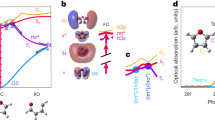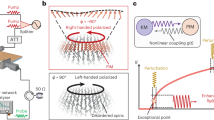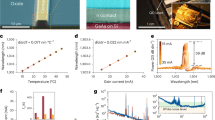Abstract
The creation of a photon–atom bound state was first envisaged for the case of an atom in a long-lived excited state inside a high-quality microwave cavity1,2. In practice, however, light forces in the microwave domain are insufficient to support an atom against gravity. Although optical photons can provide forces of the required magnitude, atomic decay rates and cavity losses are larger too, and so the atom–cavity system must be continually excited by an external laser3,4. Such an approach also permits continuous observation of the atom's position, by monitoring the light transmitted through the cavity5,6,7,8,9. The dual role of photons in this system distinguishes it from other single-atom experiments such as those using magneto-optical traps10,11,12, ion traps13,14 or a far-off-resonance optical trap15. Here we report high-finesse optical cavity experiments in which the change in transmission induced by a single slow atom approaching the cavity triggers an external feedback switch which traps the atom in a light field containing about one photon on average. The oscillatory motion of the trapped atom induces oscillations in the transmitted light intensity; we attribute periodic structure in intensity-correlation-function data to ‘long-distance’ flights of the atom between different anti-nodes of the standing-wave in the cavity. The system should facilitate investigations of the dynamics of single quantum objects and may find future applications in quantum information processing.
This is a preview of subscription content, access via your institution
Access options
Subscribe to this journal
Receive 51 print issues and online access
$199.00 per year
only $3.90 per issue
Buy this article
- Purchase on Springer Link
- Instant access to full article PDF
Prices may be subject to local taxes which are calculated during checkout




Similar content being viewed by others
References
Haroche, S., Brune, M. & Raimond, J. M. Trapping atoms by the vacuum field in a cavity. Europhys. Lett. 14, 19–24 (1991).
Englert, B.-G., Schwinger, J., Barut, A. O. & Scully, M. O. Reflecting slow atoms from a micromaser field. Europhys. Lett. 14, 25–31 ( 1991).
Hood, C. J., Chapman, M. S., Lynn, T. W. & Kimble, H. J. Real-time cavity QED with single atoms. Phys. Rev. Lett. 80, 4157–4160 (1998).
Münstermann, P., Fischer, T., Maunz, P., Pinkse, P. W. H. & Rempe, G. Dynamics of single-atom motion observed in a high-finesse cavity. Phys. Rev. Lett. 82, 3791– 3794 (1999).
Rempe, G. One atom in an optical cavity: Spatial resolution beyond the standard diffraction limit. Appl. Phys. B 60, 233– 237 (1995).
Quadt, R., Collett, M. & Walls, D. F. Measurement of atomic motion in a standing light field by homodyne detection. Phys. Rev. Lett. 74, 351–354 (1995).
Mabuchi, H., Turchette, Q. A., Chapman, M. S. & Kimble, H. J. Real-time detection of individual atoms falling through a high-finesse optical cavity. Opt. Lett. 21, 1393– 1395 (1996).
Münstermann, P., Fischer, T., Pinkse, P. W. H. & Rempe, G. Single slow atoms from an atomic fountain observed in a high-finesse optical cavity. Opt. Commun. 159, 63– 67 (1999).
Mabuchi, H., Ye, J. & Kimble, H. J. Full observation of single-atom dynamics in cavity QED. Appl. Phys. B 68, 1095– 1108 (1999).
Hu, Z. & Kimble, H. J. Observation of a single atom in a magneto-optical trap. Opt. Lett. 19, 1888 (1994).
Ruschewitz, F., Bettermann, D., Peng, J. L. & Ertmer, W. Statistical investigations on single trapped neutral atoms. Europhys. Lett. 34, 651–656 ( 1996).
Haubrich, D. et al. Observation of individual neutral atoms in magnetic and magneto-optical traps. Europhys. Lett. 34, 663– 668 (1996).
Neuhauser, W., Hohenstatt, M., Toschek, P. E. & Dehmelt, H. Localized visible Ba+ mono-ion oscillator. Phys. Rev. A 22, 1137–1140 (1980).
Wineland, D. J. & Itano, W. M. Spectroscopy of a single Mg+ ion. Phys. Lett. A 82 , 75–78 (1981).
Ye, Y., Vernooy, D. W. & Kimble, H. J. Trapping of single atoms in cavity QED. Phys. Rev. Lett. 83, 4987–4990 (1999).
Berman, P. R. (ed.) Cavity Quantum Electrodynamics (Academic, San Diego, 1994).
Horak, P., Hechenblaikner, G., Gheri, K. M., Stecher, H. & Ritsch, H. Cavity-induced atom cooling in the strong coupling regime. Phys. Rev. Lett. 79, 4974–4977 (1997).
Hechenblaikner, G., Gangl, M., Horak, P. & Ritsch, H. Cooling an atom in a weakly driven high-Q cavity. Phys. Rev. A 58, 3030–3042 (1998).
Carmichael, H. An Open Systems Approach to Quantum Optics (Springer, Berlin, 1993).
Mølmer, K., Castin, Y. & Dalibard, J. Monte Carlo wave-function method in quantum optics. J. Opt. Soc. Am. B 10, 524– 538 (1993).
Mancini, S., Vitali, D. & Tombesi, P. Stochastic phase space localization for a single trapped particle. Phys. Rev. A (in the press).
Cirac, J. I., Zoller, P., Kimble, H. J. & Mabuchi, H. Quantum state transfer and entanglement distribution among distant nodes in a quantum network. Phys. Rev. Lett. 78, 3221–3224 (1997).
Law, C. K. & Eberly, J. H. Arbitrary control of a quantum electromagnetic field. Phys. Rev. Lett. 76, 1055–1058 (1996).
Law, C. K. & Kimble, H. J. Deterministic generation of a bit-stream of single-photon pulses. J. Mod. Opt. 44 , 2067–2074 (1997).
Kuhn, A., Hennrich, M., Bondo, T. & Rempe, G. Controlled generation of single photons from a strongly coupled atom-cavity system. Appl. Phys. B 69, 373–377 (1999).
Acknowledgements
We thank P. Münstermann for important contributions to the experiment. The experiments were performed at the University of Konstanz. Funding by the Deutsche Forschungsgemeinschaft, the Optikzentrum Konstanz and the TMR network ‘Microlasers and Cavity QED' is gratefully acknowledged.
Author information
Authors and Affiliations
Corresponding author
Rights and permissions
About this article
Cite this article
Pinkse, P., Fischer, T., Maunz, P. et al. Trapping an atom with single photons. Nature 404, 365–368 (2000). https://doi.org/10.1038/35006006
Received:
Accepted:
Issue Date:
DOI: https://doi.org/10.1038/35006006
This article is cited by
-
Enhancing the direct charging performance of an open quantum battery by adjusting its velocity
Scientific Reports (2023)
-
Dynamics and Protection of Quantum Discord of a Two-qubit System Moving in a (non)-Markovian Reservoir Under a Classical Driving: Two-photon Relaxation
International Journal of Theoretical Physics (2022)
-
An easy to construct sub-micron resolution imaging system
Scientific Reports (2020)
-
Creating a switchable optical cavity with controllable quantum-state mapping between two modes
Scientific Reports (2018)
-
Beam Splitter-Mediated Quantum Information Processing Employing Momentum States of the Neutral Atoms
International Journal of Theoretical Physics (2015)
Comments
By submitting a comment you agree to abide by our Terms and Community Guidelines. If you find something abusive or that does not comply with our terms or guidelines please flag it as inappropriate.



